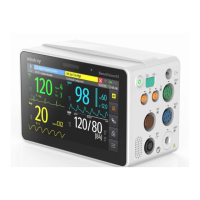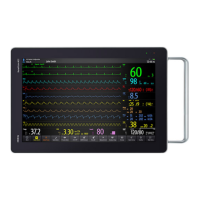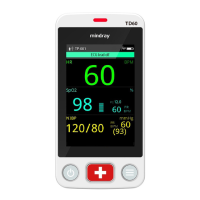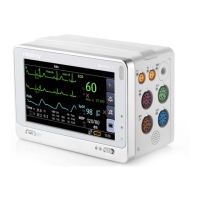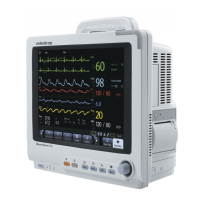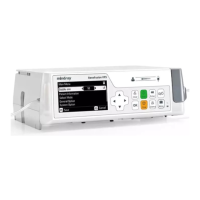29 - 2 BeneVision N Series Patient Monitor Operator’s Manual
• Never touch the electrodes unless the stimulation has been stopped.
• Check each time before use that the material insulating the NMT sensor and the stimulation cable is
intact and does not show signs of wear and tear.
• NMT monitoring is intended as an adjunct in patient assessment and must be used in conjunction
with observation of clinical signs and symptoms.
• NMT stimulation can be painful to a non-sedated patient. It is recommended not to stimulate before
the patient is adequately sedated.
• Use only electrodes suitable for nerve stimulation deemed appropriate by the attending physician.
• Pay special attention to current densities exceeding 2 mA r.m.s/cm2 for any electrodes.
29.3 Stimulation Modes
The NMT module provides the following stimulation modes. Some stimulation modes require a minimum
neurophysiological recovery time and during this recovery phase no new stimulation can be started. So you
cannot start a measurement or calibration.
29.3.1 Train-Of-Four (TOF)
TOF mode is recommended for most cases.
In TOF mode, four stimulation pulses are generated at 0.5 second intervals. Each stimulation of the train causes
the muscle to contract. The fade in the individual response to each single stimulation provides a basis for
evaluation. The response is measured after each stimulus and the ratio of the fourth to the first response of the
TOF sequence is calculated resulting in TOF-Ratio (TOF%).
When relaxation deepens, the TOF% declines until the fourth response disappears and no TOF% is calculated.
Low response to the first stimulus (T1) also results in TOF% unavailable. When no TOF% is available, the degree
of neuromuscular block is estimated from the number of responses or TOF counts. The fewer the response count
is detected, the deeper is the relaxation.
If NMT calibration establishes the reference response amplitude, response to T1 as percentage of the reference
value is calculated resulting in T1%.
In TOF mode, the minimum neurophysiological recovery time is 10 seconds. If NMT measurement or calibration
is initiated during this period, it will be automatically delayed.
29.3.2 Single Twitch (ST)
In single twitch (ST) stimulation, the module delivers a single electrical pulse and measures the strength of the
resulting twitch, the module then calculates the ratio of measured response to the reference twitch resulting in
ST-Ratio.
ST mode is practical when using depolarizing relaxants since TOF% does not give any additional information
about the patient status. Additionally, when the change of patient’s relaxation level is considered, ST stimulation
at a frequency of 1 Hz can indicate the relaxation change in a more real-time way.
29.3.3 Post-Tetanic Count (PTC)
When neuromuscular block deepens, different parameters are needed to measure the response. At first, when
the response to the fourth TOF stimulation pulse disappears or the first twitch is very weak, the TOF% is not
available and only the number of detected counts can be observed. When stimulation pulses no longer give any
stimulation response, you do not get the TOF count either. To monitor the relaxation level, you can start tetanic
stimulation and estimate the relaxation level from the Post Tetanic Count (PTC).
PTC stimulation mode starts with a sequence of four current pulses delivered at 2 Hz. If a muscle response is
detected, the PTC sequence is stopped and the TOF result is reported. If there is no muscle response, the
sequence continues with a five seconds long tetanic stimulation delivered at 50 Hz, followed by a pause of 3
seconds, followed by 20 single current pulses delivered at 1 Hz. The number of detected responses is counted
and expressed as PTC. The fewer responses are detected, the deeper is the relaxation.

